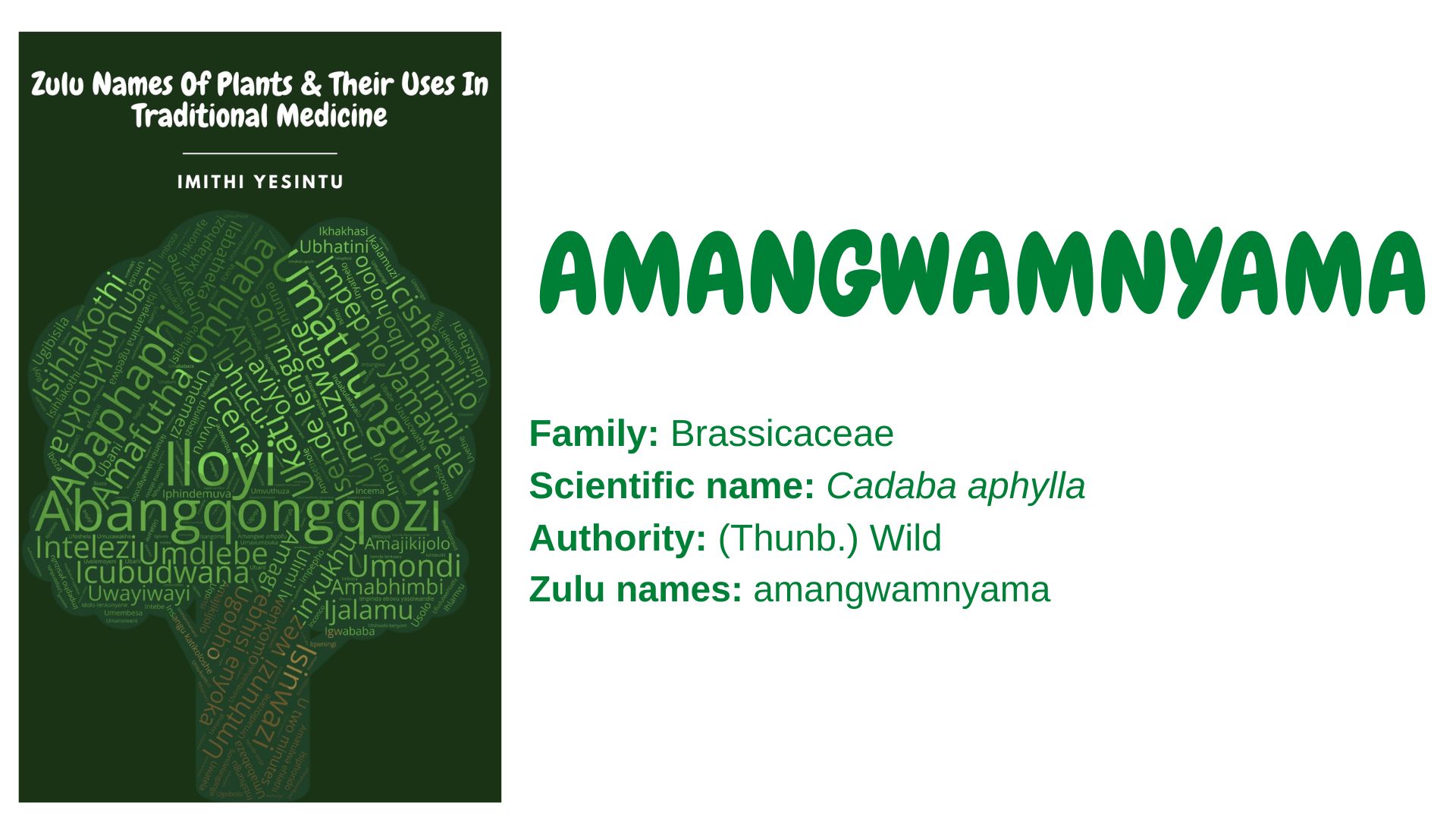Family: Brassicaceae
Scientific name: Cadaba aphylla
Authority: (Thunb.) Wild
Synonym: Cleome aphylla Thunb.
Zulu names: amangwamnyama, amangwe amnyama, amangwansundu, amangwe ansundu
Other names: black storm, leafless Cadaba, leafless worm bush (English), bloustam, bobbejaanarm, swartbos, swartstormbos (Afrikaans)
Plant description: C. aphylla is a shrub that grows to 2 m in height. It is leafless or has reduced leaves, reddish flowers, and fruits that turn rusty brown when ripe that contain small black seeds. The shrub is resilient (can grow in dry habitats and is frost-tolerant) and occurs across various habitats in Southern Africa.
There are claims regarding the plant being poisonous, but there is no real proof of this.
Uses:
- The leaves and stems are used to make an infusion that is taken orally to treat hypertension (high blood pressure).
- The leaves and stems are used to make an infusion that is taken orally to treat gastrointestinal issues.
- The leaves and stems are used to make an infusion that is taken orally to treat diabetes.
- Plant extracts are used as anticancer agents against cancer cells, such as breast, renal, and melanoma cancer cells.
- The roots are mixed with the bulb of Siphonochilus aethiopicus and the leaves and bulb of Drima robusta. The mixture is crushed and applied on all body parts to limit attack by measles.
- The leaves are mixed with the roots of Berchemia discolor and Amaranthus hybridus. The mixture is burnt and mixed with animal oil (i.e., crocodile oil or python oil) and smeared on the body to protect (immunise and strengthen) a newborn baby.
- The leaves are mixed with the roots of Berchemia discolor and Amaranthus hybridus. The mixture is crushed and wrapped into a piece of cloth which is sewn and put around the neck of a child to render it less susceptible to disease.
- The roots are used as a blood cleaning agent. For example, the roots are mixed with those of Dicoma galpinii, Ziziphus zeyheriana, and Senna italica boiled and taken orally.
- The roots, leaves, and stem are used to make poultice that is applied to treat wounds, sores, boils and abscesses.
- The roots are used to treat fractures.
- The roots are used to make a decoction that is taken orally to treat headache.
- The roots are used to treat asthma.
- The roots are used in small doses as a tonic and also as a purgative.
- The plant is cultivated as a garden ornamental.
- There is a local superstition that states that burning the wood of this plant will make the wind blow.
Safety precaution:
Using traditional medicine responsibly can enhance your overall health and well-being. Misuse and abuse can lead to complications. You can inquire about the correct use of traditional medicine from a knowledgeable herbalist and practitioner. You can also visit imithiyesintu.co.za or email: info@imithiyesintu.co.za to learn more about traditional medicine
References and further reading:
- Foden, W. and Potter, L. 2005. Cadaba aphylla (Thunb.) Wild. National Assessment: Red List of South African Plants version 2020.1. Accessed on 2023/03/20
- Fouche, G., Cragg, G.M., Pillay, P., Kolesnikova, N.I., Maharaj, V.J., and Senabe, J., 2008. In vitro anti-cancer screening of South African plants. J. Ethnopharmacol. 119, pp. 455-461.
- Immaculate, A.A., Vimala, J.R. and Takuwa, D.T., Phytochemical analysis in roots and tubers of Botswana medicinal plants-Solanum Aculeastrum dunal, Elephantorrhiza elephentina, Cadaba aphylla (Thunb) AND Adenia glauca.
- Ndou, R. V. 2018. A study of ethnoveterinary medicine in the North West Province, South Africa. MSc Dissertation, North-West University, South Africa.
- Rankoana, S.A., 2016. Curative care through administration of plant-derived medicines in Sekhukhune District Municipality of Limpopo province, South Africa. African Journal of Traditional, Complementary and Alternative Medicines, 13(2), pp.47-51.
- Rankoana, S.A., 2016. Indigenous plant-derived medicine used by ordinary community members other than traditional health practitioners for preventive health care in Mohlaletsi community in Limpopo province, South Africa. African Journal of Traditional, Complementary and Alternative Medicines, 13(3), pp.113-116.
- Setshogo, M.P. and Mbereki, C.M., 2011. Floristic diversity and uses of medicinal plants sold by street vendors in Gaborone, Botswana.
- Van Wyk, B.E., and Gericke, N., 2000. People’s Plants, a Guide to Useful Plants of Southern Africa, 1st ed. Briza Publications, Pretoria
- Voigt, W., 2004. Cadaba aphylla (Thunb.) Wild (Capparaceae).
You Can Order Your Copy Of The Book By Emailing: info@imithiyesintu.co.za
Feel Free To Add Other Uses Of This Plant In The Comment Section Below:
